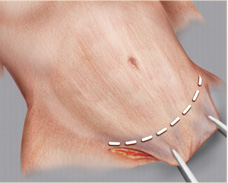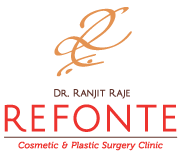
Liposuction
Liposuction is the surgical removal of localized or regional excess fatty tissue.
Areas where Liposuction can be done
- Abdomen and waist
- Thighs
- Inner Knee
- Hips and Buttocks
- Back
- Calves and Ankles
- Cheeks Chin And Neck
- Upper Arms
Is Liposuction a permanent solution?
- Liposuction can permanently reshape body contours where excess fat deposits create areas that are disproportionatelylarge in an otherwise balanced figure.
- Liposuction is not a treatment for obesity or a substitute for proper diet and exercise. It is not an effective treatment for cellulite (dimpled skin on thighs, hips and buttocks)
Surgical Procedure
- Performed under General or Regional Anaesthesia.
- Infusion of large volume of fluid for loosening the fat giving the area local anaesthesia.
- Through Small incisions in or near the area to be suctioned appropriate sized cannula is introduced.
- Cannula tip loosens the fat and a power driven vacuum pump suctions out the fat.
- Removed fat can used to fill wrinkles, hollow areas of the face or depressions anywhere on the face or the body.
- Compression garments assist during healing by helping the skin to conform to reduced body contours.
Progress and Healing
- Initial healing includes swelling, numbness soreness and bruising, that can be controlled by medication.
- Compression garment is to be worn for minimum three weeks after the procedure.
- Initial healing may take 5 to 10 days the time for suture removal if any sutures are put.
- Healing continues for several weeks as the swelling continues to dissipate.
- Return to normal light activity is possible after one week.
Abdominoplasty
Tummy or abdominoplasty is the surgical removal of excess fat and skin and restoration of weakened or separated muscles creating a smoother and firmer abdomen in profile.
A flat and toned abdomen is something most of us strive for with exercise and weight control. Sometimes these methods fail to achieve our goals.
The most common causes of loose and sagging include
- Aging
- Heredity
- Pregnancy
- Prior surgery
- Significant fluctuations in weight
Surgical Procedure
- Abdominoplasty is done under general / spinal anaesthesia
- A transverse cut is made on the lower abdomen from the pelvic bone on one side to the other .
- The loose skin is raised above the muscles
- The umbilicus is cored out from the skin to be discarded
- The abdominal muscles are tightened
- The excess loose skin above the original umbilicus along with the fat is excised
- The remaining skin is stretched and stitched to the lower cut end of the skin
- The cored out umbilicus is brought out of this skin and stitched to it.
- Drains are placed to prevent fluids from accumulating .
- A corset pressure garment is put which has to be worn at least for 4 weeks.
Progress and Healing
- Bruising, swelling is expected
- Drains are removed after 48 hours
What is not possible!
- A tummy tuck is not a substitute for weight loss or an appropriate exercise program.
- Although the results of a tummy tuck are technically permanent, the positive outcome can be greatly diminished by significant fluctuations in your weight. For this reason, individuals who are planning substantial weight loss or women who may be considering future pregnancies would be advised to postpone a tummy tuck.
- A tummy tuck cannot correct stretch marks, although these may be removed or somewhat improved if they are located on the areas of excess skin that will be excised.


Gynaecomastia
Male breast development happens in approximately 40 to 60 percent of men. Certain drugs are also responsible for this condition. Breast reduction in men removes fat and glandular tissue from the chest to make it flatter firmer and better contoured.
Fit young men are considered the best candidates for male breast reduction.
Surgical Procedure
- The removal of excess tissue is done with a combination of liposuction and gland excision
- Liposuction cannula is inserted through a small incision on the outer side (lateral) of the chest and the fat is sucked out.
- The glandular tissue is excised through an inconspicuous cut on the lower edge of the areola
- Pressure dressing and compression garment are a part of the standard procedure.
Progress and Healing
- This procedure requires single day hospital stay.
- Bruising and swelling is expected for few weeks after the operation
- Compressing garment is recommended for a period of two weeks
- Exercise and physical activity can be resumed after two weeks
